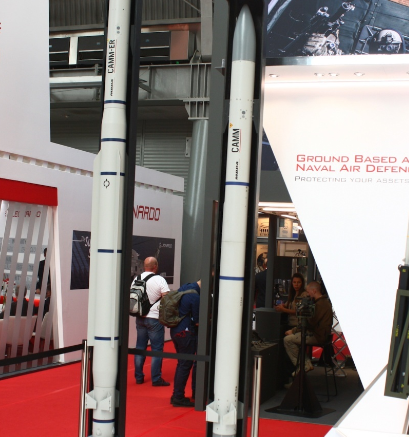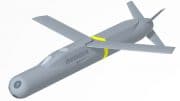Camm-ER, production of new MBDA-produced missile has started
It is called CAMM-ER (Common Anti-air Modular Missile Extended Range), and it is the new missile in production at Mbda, a multinational company engaged in 45 missile systems and countermeasures programs, with a global market share of 20 percent (more than a third of the market outside the United States), and three active plants in Italy: Rome, La Spezia and Fusaro.
The CAMM ER is the designated replacement for the Aspide air defense missile, which is scheduled to be decommissioned by 2021 and on which the Italian Navy’s Albatros, the Italian Army’s Skyguard and the Italian Air Force’s Spada medium-range air defense systems are centered.
It is the extended-range member of the next-generation CAMM family of air defense weapons. All CAMM family members share the same state-of-the-art active radar seeker and soft launch system, with CAMM-ER equipped with a larger rocket motor to provide extended range beyond 40 km.
CAMM and CAMM-ER form the basis of MBDA’s Enhanced Modular Air Defence Solutions (EMADS) offering. MBDA has successfully completed a series of trials of the CAMM-ER air defense missile, validating the system’s high performance.
The tests were conducted over the past several months and featured a series of successful CAMM-ER launches that demonstrated the missile’s performance at extended ranges and high altitudes while conducting a series of challenging maneuvers. The Skyguard and Spada systems, in particular, born for the point defense of targets such as military bases, airports, ports, and strategic infrastructures in case of conflict, after 9/11 are also used for the defense of civilian targets from potential terrorist threats, especially in the case of “big events” such as, for example, the G8 in Genoa in 2001, the NATO-Russia summit held in Pratica di Mare in 2002 and the funeral of Pope John Paul II in 2005.
A further update of the Aspide missile, the result of a project dating back to the 70s, is made impossible by the insurmountable obsolescence reached by most of its components and by the degradation of the materials, including the pyrotechnic ones, which impose its decommissioning starting from 2021.
The objective of the CAMM ER program is to provide the Armed Forces with a short/medium range air defense system able not only to replace the Aspide, but also to offer a flexibility of use and operational capabilities fully responding to the needs dictated by the current and foreseeable scenarios of use.
The EMADS – CAMM ER system offers 360° protection capabilities, in any weather condition, even in the presence of electronic countermeasures, against multiple targets. It offers a range of about and is effective against aerial targets of all types (Remotely Piloted Aircrafts, helicopters, airplanes, subsonic missiles, supersonic missiles). It is characterized by high mobility even in impervious terrain and can be transported by land, rail, sea or air.
The CAMM ER missile is an evolution of the CAMM currently in production under the British Sea Ceptor (installation of the first systems is underway on the Type 23 frigates to replace the Sea Wolf system; it will also be integrated on future Type 26 frigates) and Land Ceptor (to replace the Rapier land systems) programs.
The homogeneity of components between the two missiles is high, and this allows to produce significant economies between the British and the Italian systems, both during development and production, and during maintenance in service. Compared to the CAMM missile, the CAMM ER is significantly longer (4.2 m vs. 3.2 m) and heavier (160 kg vs. 99 kg). This is due to the integration of a new and more powerful engine, produced in Italy by Avio, which gives it an almost double range (about 45 km).
This propulsion system, characterised by a body in composite materials, is realised with the introduction of technological innovations such as the use of highly modular resins that allow the engine to resist the thermal environment and guarantee a low level of combustion of the propellant which, in combination with a propellant grain with a particular shape, allows both the booster phase (acceleration) and that of sustaining the flight. Other differences include some changes to the sensor and test components and a new aerodynamic configuration with four low-elongation wings that extend along the center-rear section of the missile.
While having different physical characteristics, the CAMM ER employs the same Italian-developed launcher as the CAMM with the use of an enlarged missile canister. The CAMM ER employs an innovative Soft Vertical Launch system, which sees the ejection of the missile from the canister “cold” (with the use of a gas generator) and the activation of the engine when the missile is distant and already in the “turn-over” phase. This prevents the launch area from being hit by the engine jet, to the benefit of launcher integrity and personnel safety. The active RF (Radio Frequency) seeker with solid-state transmitter is the same as the CAMM and ensures maximum performance in all weather conditions, unlike seekers based on infrared technology, such as the IRIS-T; as well as the two-way datalink that allows the missile to be constantly updated on the position of the threat (detected by the battery’s firing radar or transmitted by an external source) and to accurately guide it to a sufficient distance from the target to allow the seeker to “lock on”. In particular, seekers, radars that constitute the “brain of the missiles”, will be produced in Italy through an order that Lorenzo Mariani, executive group director Sales & Business Development and managing director of Mbda Italia, has defined as “a few hundred million euros”. The series production of CAMM-ER will start during 2022.
Fabio Gigante for AeroMorning









Be the first to comment on "New missile in production at MBDA"